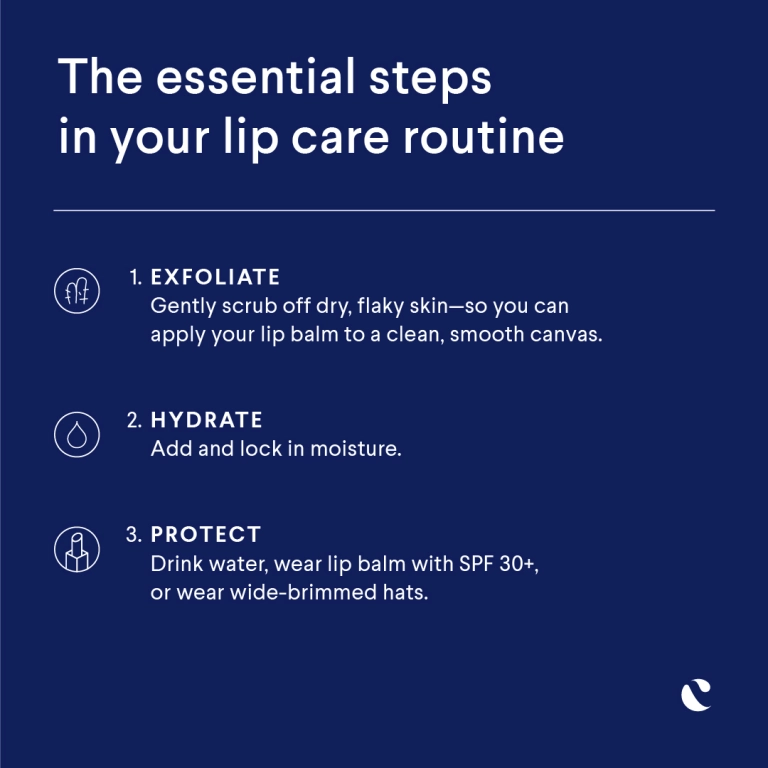How it works:
Share your skin goals and snap selfies
Your dermatology provider prescribes your formula
Apply nightly for happy, healthy skin
How it works:
How it works:
Share your skin goals and snap selfies
Your dermatology provider prescribes your formula
Apply nightly for happy, healthy skin
How it works:
Lip balm vs lip gloss: which is better for your lips?
How to choose between lip balm vs lip gloss: your full guide.



When it comes to your lips, there are loads of products to choose from — lip liners, liquid sticks, plumpers, and more. But are these products actually good for your lips, and do they provide any benefits beyond appearance? Or, are you better off with your faithful black and white tube of ChapStick? We get to the bottom of these questions by battling out two of the most popular products in the lip world: lip balm and lip gloss.
What is lip gloss?
Lip gloss is primarily a cosmetic product designed to give your lips a glossy finish. Note: According to the FDA, cosmetic products are used to alter a person’s appearance, but they don’t impact the human body‘s structure or functions.¹
Lip glosses are typically liquid or semi-fluid and may come packaged in a squeezable tube for applying directly to the lips. Some lip gloss tubes come with a doe foot applicator (a sponge-tipped wand) instead.
Lip gloss can add a high-shine top coat to give your favorite lipstick a glass-like finish. Or it can be applied on its own to add a shine to your natural lip color. You can also buy tinted lip gloss, which comes in just about every shade imaginable. From metallic shimmers to subtle pinks, these liquids add a pop of color and glossiness to make your lips stand out.
Okay, but what’s the difference between lip balm and lip gloss when it comes to ingredients?
Every lip gloss has its own combination of ingredients, but these are some common ones:
Emollients moisturize and soften the skin. Synthetic and refined emollients include squalane and mineral oils. Lanolin and jojoba are natural, moisturizing emollients.
Thickeners help keep the gloss on your lips. They include waxes, like ozokerite, and clays, like kaolin.
Coloring agents, like dyes, pigments, mica, and iron oxide, create different hues and add sparkle.
Polybutene and polyisobutene² act as binding agents to create a sticky texture.
Finally, the million-dollar question: are there benefits to lip gloss from a medical perspective? This can depend on the product formula.
Some lip glosses have benefits due to additional ingredients, like zinc oxide or titanium dioxide (for sun protection), and moisturizing ingredients, like glycerin or jojoba oil. Other lip glosses, however, may have pore-clogging ingredients that can lead to acne around your mouth.
We recommend carefully reading each product label to know what ingredients you’re applying to your lips. If you’re ever uncertain about an ingredient, Curology’s licensed dermatology providers are here to help.
What is lip balm?
Lip balm is generally meant to moisturize your lips and treat and help prevent chapped and cracked lips. Most lip balms are wax-like substances packaged in sticks, jars, or roll-on containers.
Things get a bit technical when it comes to lip balm product classification. Your standard lip balm is a cosmetic product. But a lip balm with active ingredients that treat a medical condition is both a cosmetic and a drug.³ An example is a lip balm that treats cold sores.
And, unlike lip gloss, lip balm is not typically a makeup product. It’s generally considered a personal care product and skin protectant.
Here are some common ingredients that may be found in lip balm:
(Keep in mind that this is by no means an all-inclusive list. Different lip balm brands will have their own product ingredients.)
Beeswax and carnauba wax
Cocoa butter, shea butter, and palm butter
Petrolatum and petroleum jelly
Lanolin
Honey
Plant oils like jojoba, almond, and avocado oil
Vitamin E
Hemp seed oil and castor seed oil
Dimethicone
Coloring and flavoring agents
Most lip balms are made to give your lips the care they need. But are there any disadvantages of lip balm?
Lip balms made with certain ingredients may harm your lips by drying them out instead of moisturizing them.⁴ And, like lip gloss, some ingredients in lip balms may be comedogenic, potentially clogging the pores around your mouth.
Check out our helpful list of common pore-clogging ingredients to avoid.
Lip balm vs lip gloss: which is better for my lips?
Because the purposes of lip gloss and lip balm can differ, your final choice will depend on your goals. Although some lip glosses have hydrating and protecting benefits, they’re more often beauty products. For healthy, hydrated skin, lip balm is probably your best bet.
The good news? You don’t have to choose one or the other. Applying lip balm regularly will keep your lips healthy and create a smooth canvas on which you can apply beauty products like lip gloss.

Wondering which lip balm is best for daily use? Dermatologists recommend applying a non-irritating lip balm throughout the day and before you go to bed.⁵ When outdoors, apply a lip balm with SPF 30 or higher every two hours. Add some gentle exfoliation to the mix, and your lip care routine will be good to go.
Take care of your lips with Curology
Getting your lips to pouty perfection shouldn’t be a game of trial and error. If you’d like expert advice on how to use lip balm, Curology is here to help.

Our dermatologists have developed an acne-friendly, non-greasy lip balm to soften and soothe your lips. It’s packed with all the good stuff, like natural butters, plant-based oils, and even SPF 30!
Get your personalized skincare routine with Curology
Get your personalized skincare routine with Curology


Sign up for a Curology trial* and get your Curology lip balm along with other customized products picked for your skin goals. Take a quick quiz, send us some selfies, and kiss dry lips goodbye.
FAQs
This depends on what you’re trying to achieve with your lip product. If you want to relieve dry or chapped lips, a lip balm can provide your lips with the hydration they need. But if your motive is more aesthetic, lip gloss can make your lips shimmer.
Lip balms with the right ingredients moisturize dry lips and help protect them from the sun. But some lip balms may contain ingredients that can harm your lips and cause irritation. Keep in mind that everyone’s lips are different.
Nope, and let’s make this distinction clear. ChapStick is one of many lip balm brands, like Curology and Burt’s Bees. Lip gloss is a makeup product that adds shine and color to the lips.
P.S. We did the homework so you don’t have to:
U.S. Food and Drug Administration. Cosmetics Labeling Guide. (2022, February 25).
American College of Toxicology. Final Report of the Cosmetic Ingredient Review Expert Panel on the Safety Assessment of Polyisobutene and Hydrogenated Polyisobutene as Used in Cosmetics. International Journal of Toxicology. (July 2008).
U.S. Food and Drug Administration. Are all "personal care products" regulated as cosmetics?. (2022, June 16).
Kokil, S., et al. Review on Natural Lip Balm. International Journal of Research in Cosmetic Science. (August 2014).
American Academy of Dermatology Association. How to prevent and treat dry, chapped lips. (2021, January 26).
Melissa Hunter is a board certified family nurse practitioner at Curology. She received her MSN from George Washington University in Washington, DC.
*Cancel at any time. Subject to consultation. Results may vary.

Curology Team

Melissa Hunter, NP-C